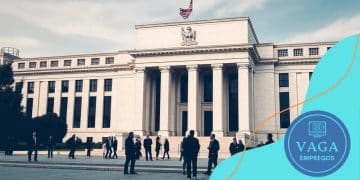Federal Reserve minutes reveal tightening bias

Advertisement
Federal Reserve minutes reveal tightening bias, indicating potential interest rate increases to control inflation while balancing economic growth and stability.
Federal Reserve minutes reveal tightening bias that could shape the economy in the upcoming months. Curious about how these insights affect you? Let’s dive into what this means for financial markets and policy.
Advertisement
Understanding the Federal Reserve’s role
Understanding the Federal Reserve’s role is crucial for grasping how monetary policy affects our economy. The Federal Reserve, often called the Fed, serves as the central bank of the United States. It implements policies that regulate the money supply and ensure financial stability.
Advertisement
The Fed’s primary functions include managing inflation, supervising and regulating banks, and providing financial services. By adjusting interest rates and controlling the money supply, the Fed influences economic growth and stability.
Key Functions
Here are some essential functions of the Federal Reserve:
- Monetary Policy: The Fed sets the nation’s monetary policy to achieve stable prices and maximum sustainable employment.
- Bank Regulation: It ensures the safety and soundness of the banking system.
- Financial Services: The Fed offers various financial services, including payment processing for banks and the government.
When the economy slows down, the Fed can lower interest rates, making borrowing cheaper. This encourages spending and investment. Conversely, during periods of rapid growth, it may raise interest rates to prevent inflation from spiraling out of control. Understanding these actions helps us make sense of economic changes that affect our daily lives.
Moreover, the Fed collects and analyzes data to inform its decisions. This data includes information on employment rates, economic growth, and consumer spending. These insights help us understand the positive and negative impacts of the Fed’s policies.
Impact on Consumers
The decisions made by the Federal Reserve directly impact consumers. When interest rates are low, it’s more affordable to take out loans for homes or cars. On the other hand, if rates rise, those plans may become more costly. This cycle can affect everything from personal savings to business investment.
In summary, the Federal Reserve plays a vital role in maintaining economic stability. By understanding its functions and actions, we can better navigate the financial landscape and make informed decisions. Keeping an eye on the Fed’s decisions helps us anticipate changes in the economy that influence our everyday lives.
Key takeaways from the latest minutes
Key takeaways from the latest minutes are essential for understanding the direction of monetary policy and the economic outlook. These insights provide valuable context about the Federal Reserve’s current stance on interest rates and inflation.
The minutes detail discussions that highlight the committee’s concerns regarding inflationary pressures. With the economy displaying signs of growth, the Fed aims to ensure that inflation remains under control.
Main Insights
Here are some important points from the latest minutes:
- Inflation Trends: The Fed members are closely monitoring inflation rates, which have shown fluctuations.
- Interest Rate Decisions: There is a strong focus on whether to raise, lower, or maintain the current rates based on economic indicators.
- Economic Growth Projections: The minutes discuss growth forecasts, indicating optimism combined with caution.
- Labor Market Analysis: Insights into employment trends help assess the overall health of the economy.
The discussions also emphasize the need for transparency in the Fed’s decision-making process. Clear communication helps manage market expectations and builds confidence among investors.
Participants in the meeting expressed varying opinions on the best approach to take regarding policy adjustments. Some members advocated for a more aggressive strategy to combat inflation, while others suggested a more gradual approach to avoid disturbing economic recovery.
Overall, analyzing the takeaways from the latest minutes helps us gauge the potential future actions of the Federal Reserve. By understanding their concerns and priorities, we can better anticipate shifts in the economic landscape that may affect various sectors and consumers alike.
The implications of recent discussions
The implications of recent discussions at the Federal Reserve are significant in shaping monetary policy. These talks address key economic issues that affect everyone, from consumers to large businesses.
During the latest meeting, Fed officials expressed concerns regarding rising inflation rates. They discussed how inflation impacts purchasing power and the overall economy. Policymakers are balancing the need to stimulate growth while ensuring prices do not rise uncontrollably.
Potential Economic Outcomes
Several outcomes could arise from these discussions:
- Interest Rate Changes: If inflation continues to rise, the Fed may opt to increase interest rates. This decision would impact borrowing costs for consumers and businesses alike.
- Market Reactions: Investors closely monitor Fed discussions, as anticipated changes can lead to fluctuations in the stock market.
- Consumer Confidence: The Fed’s actions affect how confident consumers feel about spending money. Higher interest rates might lead to reduced spending.
- Global Implications: Changes in U.S. monetary policy can influence international markets, affecting currencies and trade relationships.
As discussions continue, it is essential to note how these implications will play out. The Fed’s decisions will ultimately guide economic conditions, influencing job opportunities and financial stability.
In the coming months, the Federal Reserve plans to closely monitor economic indicators such as employment rates and consumer behavior. Their ability to adjust policies based on these factors will determine the direction of monetary policy.
Understanding the implications of recent discussions is critical for anyone interested in the economy. By staying informed, we can better prepare for economic shifts that may affect our financial lives.
Market reactions to tightening bias
Market reactions to tightening bias are significant as they reflect how investors interpret the Federal Reserve’s decisions and strategies. A tightening bias indicates a potential increase in interest rates, which can lead to various effects across financial markets.
When the Fed signals a tightening bias, stock markets often react by showing volatility. Investors may fear that higher interest rates will increase borrowing costs, which can slow down economic growth. These fears can lead to selling pressure on stocks, particularly in interest-sensitive sectors.
Impact on Different Markets
Several markets react differently to a tightening bias:
- Stock Market: Investors may favor lower-risk investments, leading to fluctuations in stock prices.
- Bond Market: Bond yields typically rise as investors demand higher returns to compensate for the increased risk of holding lower-rated bonds.
- Foreign Exchange Market: The U.S. dollar often strengthens as higher interest rates attract foreign investors seeking better returns.
- Commodities: Markets for commodities like oil may see decline since a stronger dollar can reduce demand.
Investor sentiment plays a crucial role in these reactions. Market participants often engage in speculation based on commentary from the Fed regarding future monetary policies. This speculation can lead to abrupt market movements, reflecting uncertainty and the prevailing economic climate.
Overall, understanding how markets respond to a tightening bias provides insight into how the economy may evolve in response to the Federal Reserve’s decisions. As the Fed continues to navigate inflation and growth, analysts will closely watch these market reactions for indicators of broader economic health.
Future policy directions and expectations
Future policy directions and expectations from the Federal Reserve are vital for understanding how economic conditions may evolve. As the Fed navigates a complex economic landscape, they will continue to adapt their strategies based on evolving data.
Recent discussions have indicated a cautious stance regarding inflation and economic growth. The Fed aims to balance these factors to support a stable economy while preventing excessive inflation.
Potential Directions
There are several potential future policy directions:
- Interest Rate Adjustments: Depending on inflation trends, the Fed may raise interest rates to curb spending and borrowing.
- Asset Purchases: The Fed might continue or adjust its bond-buying programs to influence money supply and interest rates.
- Forward Guidance: Clear communication from the Fed regarding future expectations will be crucial in managing market reactions.
- Monitoring Economic Indicators: The Fed will closely track indicators such as employment and consumer spending to make informed decisions.
Investors and analysts are keenly aware of these anticipated directions, as they indicate how the Federal Reserve plans to respond to ongoing economic challenges. Expectations around monetary policy can lead to significant market reactions, and staying informed helps stakeholders make better decisions.
The Federal Reserve’s credibility and transparency in their actions are crucial for maintaining investor confidence. As they lay out their future plans, the Fed will aim to ensure stability in financial markets and the economy.
Understanding these future policy directions helps economists, businesses, and consumers anticipate changes that could affect everything from mortgage rates to job growth. The Fed’s actions and policies shape the economic environment, influencing decisions at all levels.
FAQ – Frequently Asked Questions about the Federal Reserve and Market Reactions
What is the role of the Federal Reserve?
The Federal Reserve manages the nation’s monetary policy to promote economic stability and control inflation.
How do interest rate changes affect consumers?
Changes in interest rates influence borrowing costs for loans and mortgages, impacting consumer spending.
What are market reactions to tightening bias?
Market reactions often include stock price fluctuations as investors adjust their expectations based on the Fed’s signals.
Why is understanding the Fed’s policy directions important?
Understanding the Fed’s policies helps individuals and businesses anticipate economic changes that can affect financial decisions.





